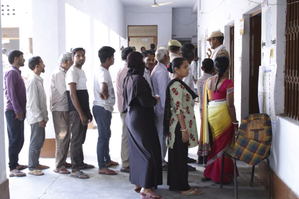Phase-2 LS polls: Voting begins in 88 constituencies; Rahul Gandhi, Hema Malini in fray
By IANS | Published: April 26, 2024 07:53 AM2024-04-26T07:53:31+5:302024-04-26T07:55:03+5:30
New Delhi, April 25 Polling for the second phase of the Lok Sabha elections started in 88 parliamentary ...

Phase-2 LS polls: Voting begins in 88 constituencies; Rahul Gandhi, Hema Malini in fray
New Delhi, April 25 Polling for the second phase of the Lok Sabha elections started in 88 parliamentary constituencies across 12 states and a Union Territory.
While 89 constituencies were slated to go to polls in the second phase, voting in Madhya Pradesh's Betul was advanced to the third phase on May 7 following the death of the BSP candidate in the fray.
Out of the 88 constituencies in the second phase, 73 are general seats, while 6 are reserved for Scheduled Tribes (ST) and 9 for Scheduled Castes (SC).
The voting commenced at 7 a.m. on Friday and will continue until 5 p.m. However, in some places, the polling time for voting may vary as per the local weather. Due to the hot weather conditions, the polling time at several polling centres in several Bihar constituencies has been extended until 6 p.m. to facilitate the voters.
Among the notable candidates contesting in this phase are Congress leader Rahul Gandhi from Kerala's Wayanad, where he faces the CPI's Annie Raja and state BJP chief K. Surendran, Congress' Shashi Tharoor vs BJP's Rajeev Chandrasekhar in Thiruvananthapuram, Hema Malini from UP's Mathura, former Chhattisgarh Chief Minister Bhupesh Baghel from the state's Rajnandgaon, Congress leader D.K. Suresh from Bangalore Rural, and BJP youth leader Tejasvi Surya from Bangalore South, Union Minister Gajendra Singh Shekhawat from Rajasthan's Jodhpur, his ministerial colleague Kailash Choudhury from Barmer, and Lok Sabha Speaker Om Birla from Kota.
This phase will mark the completion of elections in Kerala, where polling is underway in all 20 seats, Manipur, where the remaining part of Outer Manipur is voting, as well as Tripura and Rajasthan, where polling was also held in the first phase on April 19.
It second phase also marked the commencement of elections in Karnataka, where polling is underway in half of the state's 28 seats, mostly in the southern part of the state. The seats where voting commenced in the first phase of elections in the state are Udupi Chikamagalur, Hassan, Dakshina Kannada, Chitradurga, Tumkur, Mandya, Mysore, Chamarajanagar, Bangalore Rural, Bangalore North, Bangalore Central, Bangalore South, Chikballapur, and Kolar
Elections continued in Assam (Karimganj, Silchar, Mangaldoi, Nawgong, Kaliabor), Bihar (Kishanganj, Purnia, Katihar, Bhagalpur, Banka), Chhattisgarh (Rajnandgaon, Mahasamund, Kanker), Madhya Pradesh (Tikamgarh, Damoh, Khajuraho, Satna, Rewa, Hoshangabad), Maharashtra (Buldhana, Akola, Amravati, Wardha, Yavatmal Washim, Hingoli, Nanded, Parbhani), Rajasthan (Tonk-Sawai Madhopur, Ajmer, Pali, Jodhpur, Barmer, Jalore, Udaipur, Banswara, Chittorgarh, Rajsamand, Bhilwara, Kota, Jhalawar-Baran), Tripura's Tripura East, Uttar Pradesh's Amroha, Meerut, Baghpat, Ghaziabad, Gautam Buddha Nagar, Bulandshahr, Aligarh, and Mathura, and West Bengal's Darjeeling, Raiganj, and Balurghat.
Polling in J&K's Jammu seat is also underway.
According to the Election Commission, in this phase, more than 1.6 lakh polling officers have been deployed at 167,000 polling centres to facilitate the casting of ballots by 15.88 crore voters.
These include 3.48 lakh first-time voters, and 3.28 crore young voters aged between 20 and 29.
On the other hand, there are 14.78 lakh registered voters aged 85 years or above, 42,226 voters aged over 100 years, and 1.47 lakh differently-abled voters, who have been provided with the option to cast their votes comfortably from their homes.
Out of 1,202 candidates in the fray, 1,098 are male, 102 are female, and 2 are of the third gender.
To facilitate the movement of polling and security personnel, four helicopters, three special trains, and around 80,000 vehicles have been deployed.
Along with the deployment of micro-observers at all polling centres, webcasting is also being done at over 50 per cent of the polling centres, with more than 1,00,000 polling centres being webcasted.
Disclaimer: This post has been auto-published from an agency feed without any modifications to the text and has not been reviewed by an editor
Open in app